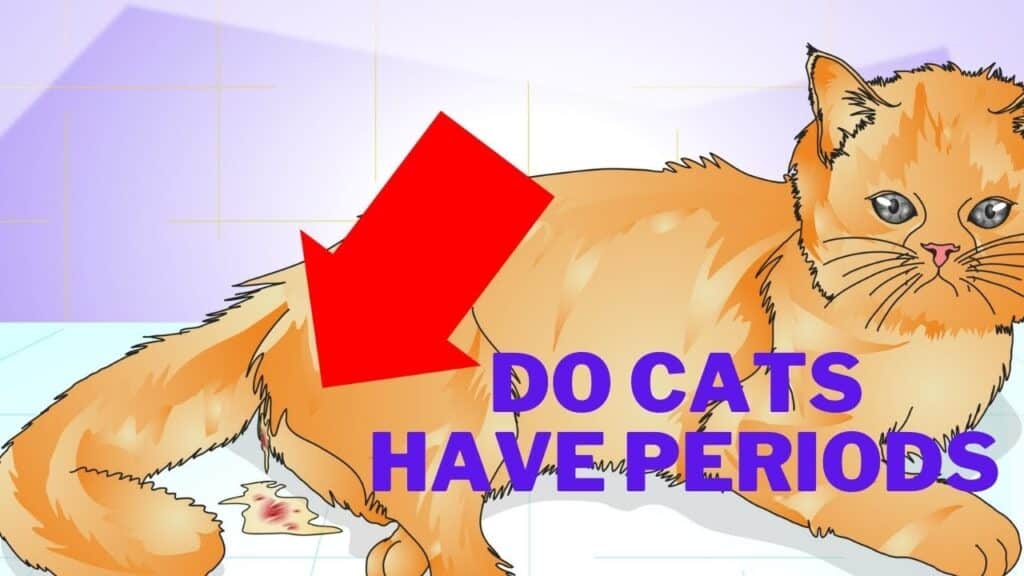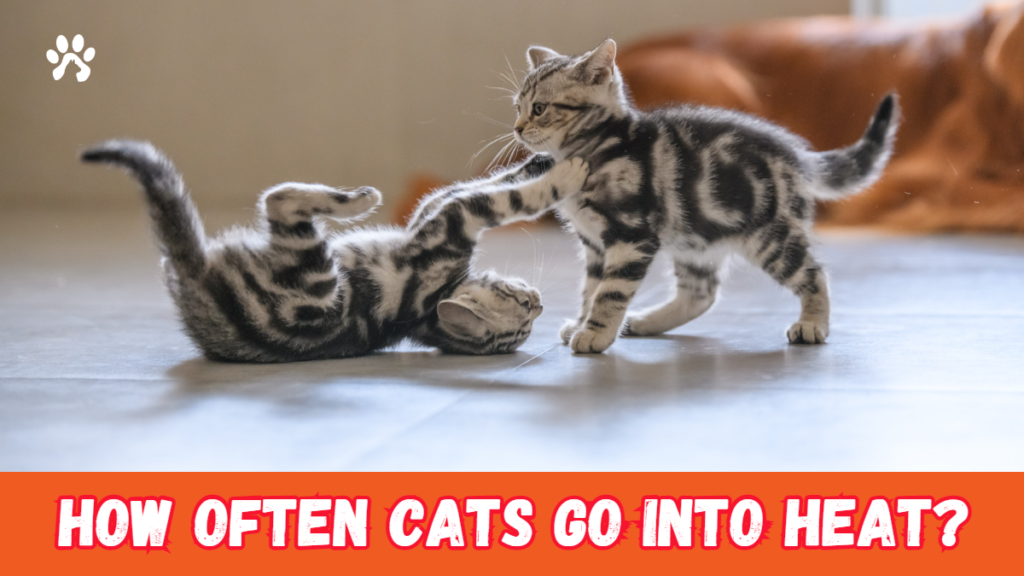As a cat owner, it is essential that you have a solid grasp of your feline companion’s estrus cycle, in order to protect her reproductive health and avoid unintended pregnancy. when do cats get their period? The estrus cycle, commonly referred to as the heat cycle, is a recurrent reproductive cycle that occurs in female cats. This cycle is marked by hormonal changes, which lead to changes in both the cat’s physical appearance and its behavior.
In this post, we will discuss the many phases of the estrus cycle, the signals that suggest that your cat is in heat, and the things that you can do to keep her comfortable and avoid an undesired pregnancy. We will also explain the circumstances under which you need to be worried about your cat’s periods and the circumstances under which you ought to visit a veterinarian.
The Estrus Cycle: What Is It?
The female cat’s estrus cycle, also called the heat cycle, is a cyclical phase of the female cat’s reproductive system. The cat’s body prepares for pregnancy throughout this cycle, and fertilization may also occur if mating happens. A number of hormonal changes that occur throughout the estrus cycle cause the cat to shift physically and behaviorally. It’s crucial to comprehend your cat’s estrus cycle if you wish to preserve her reproductive wellness and avoid unintended conception.
when do cats get their period?
As a cat reaches adolescence, they normally begin their estrus cycle, however this might vary by breed and cat-to-cat. While some cats may go through puberty as early as 4 months or as late as 12 months, the typical age of puberty in cats is between 5 and 10 months. The timing of the estrus cycle and the age at which cats enter puberty may both be impacted by early spaying or neutering, it is crucial to remember.


What is the duration of the estrus cycle?
Cats’ estrus cycles normally last between one and two weeks, however they may extend as long as a month. The cycle is broken down into proestrus, estrus, and post estrus phases. The cat’s body prepares for mating during the proestrus stage, and the cat is fertile and open to mating during the estrus period. The post estrus stage signals the end of the cycle, after which the cat will go into a period of sexual dormancy until the following cycle if no pregnancy develops.
Signs that Your Cat is in Heat:
Physical Signs:
Female cats have a number of physical symptoms that suggest they are in heat throughout the estrus cycle. These symptoms might include a swollen and red vulva, greater genital grooming, and a more loving attitude. Moreover, some cats may vocalize more than normal and adopt the “lordosis” pose, which involves lowering their front ends and raising their hindquarters.
Behavioral Changes:
Cats in heat exhibit a number of behavioral changes in addition to physical indicators. They could become more agitated, talkative, and energetic, as well as show their owners more love. Also, they might become more aggressive and mark their territory by rubbing their scent glands on things.
What to Do When Your Cat is in Heat:
Keeping Your Cat’s Level of Comfort:
There are a variety of things you can do to make sure that your female cat is comfortable when she is in heat. You may keep her engaged by giving her a comfortable bed, a plenty of toys, and the opportunity to play with them. You may also provide her a location to rest that is warm, quiet, and comfortable, and you should try not to handle her any more than is really required.
Preventing unwanted pregnancy
During the estrus cycle, it is critical to confine your female cat inside and keep her away from male cats in order to avoid an unintended pregnancy. You could also want to think about spaying your cat, which will stop her from coming into heat at any point in the future. To avoid unintended pregnancies and lessen the likelihood of developing a number of health issues, spaying is a method that is both reliable and efficient.
Should You Be Worried About Your Cat’s Periods?
Normal Vs Abnormal Bleeding:
During the estrus cycle, it is common for female cats to bleed, but bleeding that is excessive or continues for an extended period of time may be a symptom of a health concern. It is imperative that you take your cat to the veterinarian if the bleeding is heavy or has persisted for more than a week in order to rule out any potential underlying health concerns.
When to consult a Veterinarian:
It is imperative that you seek the advice of a qualified veterinarian if you see any behavioral or physical indicators of transition in your cat during her estrus cycle. These might include things like excessive vocalization, restlessness, heightened affection or hostility, as well as any odd discharge or bleeding. Your veterinarian will be able to do a physical checkup and give you with information about any required tests or treatments when the exam is complete. Alterations in behavior or physical indications may, in certain instances, be an indication of an underlying health condition, such as an infection or hormone imbalance, which may need medical intervention.
It is imperative that you get immediate medical assistance from a veterinarian in the event that you see any abnormal bleeding during the estrus cycle of your cat. Bleeding that is profuse or that occurs outside of the conventional menstrual cycle may be a sign of a major medical problem; however, little spotting throughout the estrus cycle is perfectly normal. Your veterinarian will be able to conduct testing to discover the underlying cause of the bleeding and will also be able to give you with treatment choices that are suitable.
In order to guarantee your cat’s overall health and well-being, it is recommended that you arrange routine wellness checkups with your veterinarian on a consistent basis. Your cat’s reproductive health may be discussed with your veterinarian, who will also be able to offer you with information on appropriate diet, exercise, and preventive care measures, as well as answer any questions that you may have. You may contribute to ensuring that your cat has a long, healthy, and happy life by collaborating closely with the veterinarian who cares for it.
Conclusion:
In conclusion, it is essential to have a solid grasp of your cat’s estrus cycle in order to protect her reproductive health and avoid unintended pregnancy. You will be able to keep your cat comfortable and prevent her from mating if you are aware of the physical and behavioral indications that indicate that she is going through her estrus cycle.
It is vital to visit a veterinarian for a comprehensive assessment if you have any worries regarding your cat’s periods, such as irregular bleeding or changes in behavior. In these cases, you should seek professional advice. In the end, having your female cat spayed is the most effective method for preventing her from ever coming into heat again and lowering the chance of developing a number of other health issues. You may guarantee that your cat has a happy and healthy life by adopting preventative steps to regulate her reproductive health. This will allow you to have more control over her life.
In addition to avoiding unplanned pregnancies, having your cat spayed may also lessen the likelihood that she will develop certain health issues, such as uterine infections and mammary tumors. Moreover, it has the potential to help minimize undesirable behaviors that often accompany the estrus cycle, like as yowling, pacing, and spraying.
If you do decide to have your cat spayed, it is imperative that you choose a trustworthy veterinarian who is able to give you with information on the process as well as any possible dangers or difficulties that may arise. In addition, it is very necessary to strictly adhere to the post-operative care recommendations in order to facilitate a speedy recovery for your feline companion. You can help your cat maintain her health and happiness throughout her whole life by providing her with the appropriate care and attention.
External Resources
you may also read:
see post

